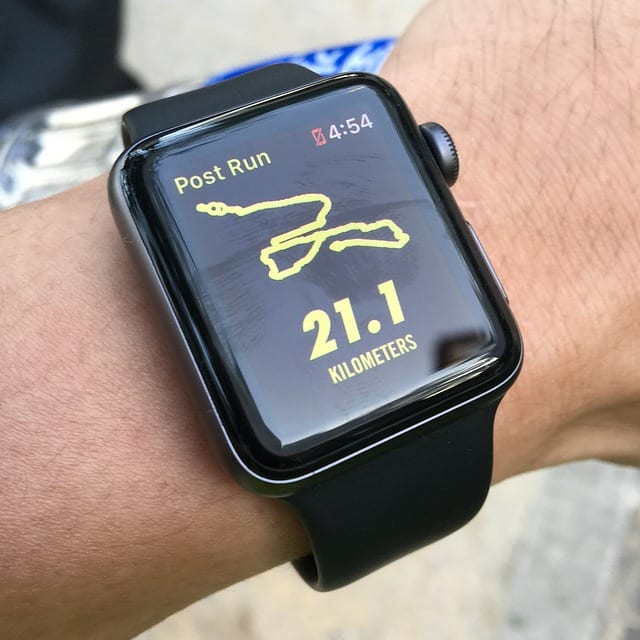Convince Your Friend to Train for a Half Marathon with You
5 ways to convince your friend to train for a half marathon with you
Maybe you have a race coming up and you don’t want to train alone. Perhaps you need some motivation to get your running groove back. Or you could have a friend who’s talked about running a half marathon, but has yet to commit. Regardless of the reason, it is time to convince your friend to train for a half marathon with you. Training with a buddy is not only fun, but inspiring as well. You can encourage each other while training for the upcoming 13.1-miler. If they’re still on the fence, convince your friend to train for a half marathon with you using the 5 tips below. Remember, running is contagious!

Incorporate a stretch routine before all runs and workouts.
Pro tip: it’s important to remember that life happens. Share how you balance life and training with your friend. That and these 5 helpful tips will give them what they need to train successfully.
1. Describe the race-day experience
Sometimes not knowing what to expect on race day can be detrimental. Take this opportunity to let your friend know what happens during race weekend. From packet pickup to the finish line festival, explain the process and what happens along the way. Provide details about the vendor-filled expo, what to expect on race morning, and the party at the finish line. Build this 4-stretch routine into your training plan and make it part of your race morning.
2. Share training information

Share information, like your favorite GPS watch, with your friend.
Share tips about how to train for the upcoming half. Provide guidance for essential items like running shoes, GPS watches, nutrition, training plans, stretching exercises, etc. Communicate what works and didn’t work for you. This is also a chance for you to determine what might be holding them back. Your friend will have lots of questions. You want to make the entire experience as enjoyable as possible for them. Think back to training for your first 13.1-miler and try to anticipate what they might need. Chances are there are a few things that’ll help them that they’re not aware of, like side stitches. Share these side-stitch prevention methods with them.
3. Provide support and encouragement
Keep in mind, running can seem daunting for a first-timer. Offer support and inspiration that’ll help them continue, even during the tough times. Take small steps and set smaller, weekly goals. Incorporate the ABCs of goal setting and they will help you both build-up to the main goal: crossing the half marathon finish line. Don’t throw your friend into full-fledged running, especially if they’ve never run before. Recall why you started running in the first place and try to impart that to your friend.
4. Work at their pace

Your insight will help your friend cross the finish line!
Your enthusiasm for the half marathon might discourage your friend who might feel less-than-ready to run. To counteract this, make your training run sessions fun. Include tunes they enjoy or run in an area they’re familiar with. Be sure to not make them burn out. Keep things at their pace, from running to the information you share. Again, revert back to training for your first half and what worked for you. If your runs are at night because of their schedule, follow these safety tips and enjoy the benefits of running at night.
5. Create friendly competition and give rewards
What better way to stimulate the passion for running than some competition. It is a fun way to challenge each other during training. Rewards can be small and inexpensive, like home-baked cookies or a new pair of socks. It shows your friend that you’re thinking of them and will incentivize them to reach their goal. When thinking about competition, it doesn’t have to be between the two of you. Challenge your friend to run half a mile further than before or a few seconds faster during a speed workout. After all, they’re their own competition.
Running is an exciting way to get fit and have fun. What better way to enjoy this sport and train for the next half marathon than with your friend? This advice will help you get them off the fence and in training mode. Establish a routine, set smaller goals, and create friendly competition to help your friend cross their first half marathon finish line!



 One of the first things you want to do is set a goal. That could be a distance, a race, or a specific distance at a certain event. If you’re just starting out, an ideal goal race would be the
One of the first things you want to do is set a goal. That could be a distance, a race, or a specific distance at a certain event. If you’re just starting out, an ideal goal race would be the  Sometimes the motivation just isn’t there. The chances of skipping a run or missing a workout are higher with first-time runners. But you’re not alone! All runners face this dilemma. One of the best ways to keep your motivation level high is to find an accountability partner. This person will meet you early in the morning and make sure y’all complete the run. Yes, you guessed it, you’ll hold them accountable too! Here are 5 additional tips for
Sometimes the motivation just isn’t there. The chances of skipping a run or missing a workout are higher with first-time runners. But you’re not alone! All runners face this dilemma. One of the best ways to keep your motivation level high is to find an accountability partner. This person will meet you early in the morning and make sure y’all complete the run. Yes, you guessed it, you’ll hold them accountable too! Here are 5 additional tips for  necessary unless it is windy or raining.
necessary unless it is windy or raining. Not really about the dress, but worth mentioning that colder weather means shorter days. Plan your runs keeping in mind that the sun sets sooner and quicker.
Not really about the dress, but worth mentioning that colder weather means shorter days. Plan your runs keeping in mind that the sun sets sooner and quicker.

